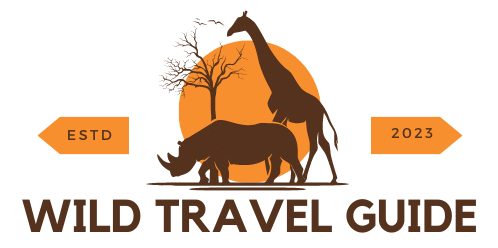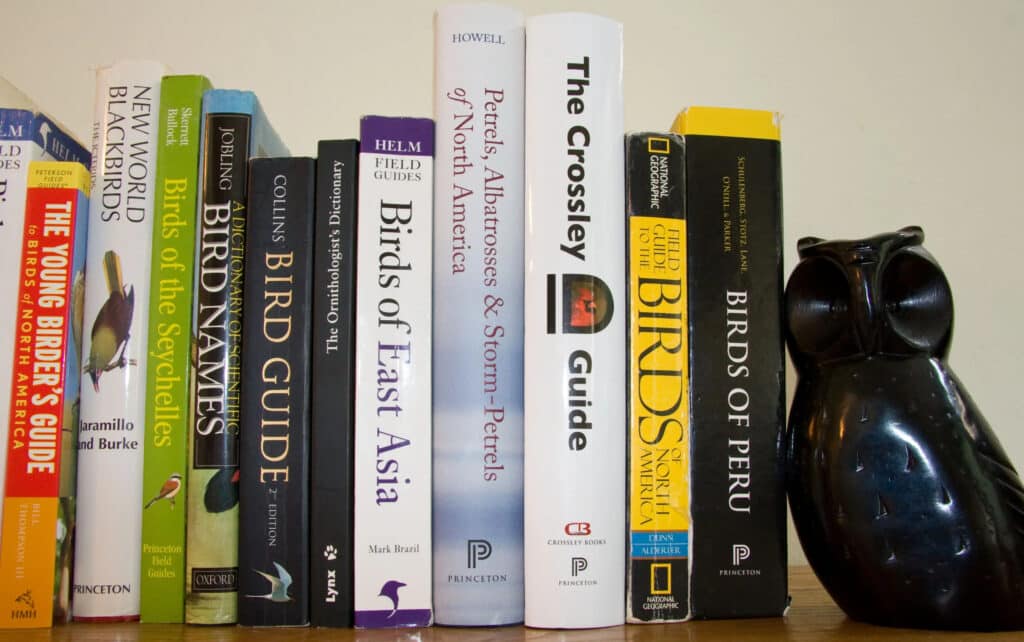I will review five bird guidebooks that I consider among the best bird books available today based on my extensive experience using them during my travels. I’ll highlight each guide’s key features, details, and advantages, providing a birder’s perspective on their usefulness for identification and learning.
The Sibley Guide to Birds
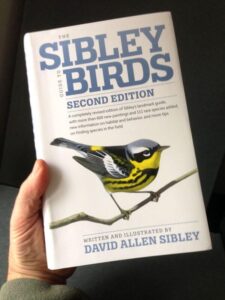
I’ve tested my share of bird guides over the years. In my experience, The Sibley Guide to Birds stands out as one of the best bird books for properly identifying birds in the field. Authored by renowned ornithologist David Allen Sibley, this comprehensive guidebook is meticulously detailed, making it invaluable for birders of all skill levels.
Spanning over 800 pages, The Sibley Guide covers more than 810 species across North America. The highlight is without a doubt the hand-painted illustrations. Sibley’s paintings accurately capture the nuances of shape, plumage, and distinctive markings that distinguish similar species. Unlike photographs, the paintings can show birds in multiple poses and from various angles. This helps immensely in noting key field marks for identification. The colors are realistic too, depicting gradients and textures that aid recognition.
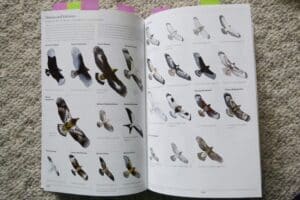
Another aspect that makes The Sibley Guide one of the best bird books is the wealth of information provided in the descriptive text. The accounts go beyond plumage details, including behaviors, habitat preferences, migration patterns, range maps, and vocalizations. As an avid traveler, I appreciate the tips on range and distribution across the continent. The comparisons between similar species help me distinguish confusing birds in the field. Even seasoned experts would appreciate the depth of detail provided.
Of course, being a field guide, portability and durability are also essential. The Sibley Guide hits the sweet spot at 5.5 x 8.5 inches – compact enough to carry in a backpack but large enough that the illustrations and text are legible. The pages are made from high-quality paper, making them usable in all hiking and travelling conditions. The binding is also sturdy, enabling the book to flex open without damage.
I highly recommend picking up a copy of The Sibley Guide for any birder identifying birds across diverse habitats. It is reasonably priced at around $20, and widely available at major bookstores and online retailers like Amazon. The wealth of illustrated detail combined with the insightful text makes this one of a birder’s library’s most valuable reference guides. Whether you’re a beginner just starting or a seasoned expert, The Sibley Guide to Birds is sure to become your trusted field companion.
National Geographic Field Guide to the Birds of North America
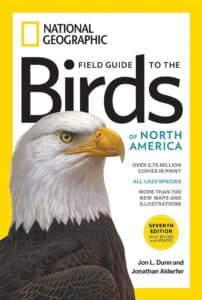
Of all the options, the National Geographic Field Guide to the Birds of North America stands out as one of the best bird books because of its wealth of photos, informative details, and user-friendly layout. With over 1,000 species covered, it is a must-have for birders exploring North America.
The National Geographic guide spans over 400 pages and provides stunning photographs depicting birds in various plumages, habitats, and behaviors. As the saying goes, a picture is worth a thousand words. The photos allow visual identification by clearly showcasing field marks and diagnostic features. The variety of poses and flight shots are extremely helpful when recognizing birds at a distance or in motion. As a blogger constantly taking pictures, I appreciate the value of photos for identification.
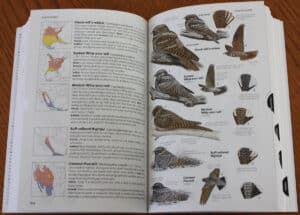
But this guidebook is more than just photographs. The descriptive text provides key details including voice, range, habitat, and migratory patterns. Icons quickly alert you to behaviors like feeding, flight style, migration, and sexual dimorphism. I find the range maps useful for gauging species distribution across the continent. The text offers identification tips and comparisons between similar species for difficult groups like gulls and shorebirds. The details supplement the photos, providing a comprehensive overview of each species.
Of course, being designed by National Geographic, you can expect top-notch quality. The pages are made of durable paper, perfect for outdoor use. The covers withstand wear and tear. At 5 x 8 inches, it’s compact enough to carry in a small backpack or large pocket. The color-coded tabs allow quick access to bird families, helpful when making fast comparisons. The layout groups related species together, aiding the identification process in the field.
For its unbeatable combination of photos, informative text, durability, and accessible layout, the National Geographic Field Guide delivers outstanding value for the price. Retailing around $25, it is one of the best bird books for travelers and experts. The wealth of information has made it my trusted field companion on adventures across North America and beyond. I never head out without it!
Birds of North America: A Guide To Field Identification
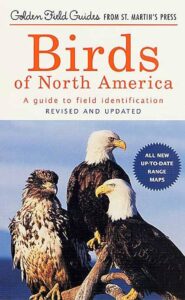
With over 800 species covered and thousands of detailed illustrations, this guidebook is a must-have reference for anyone interested in North American birds.
Created by naturalists Bertel Bruun, Herbert S. Zim, and Ira N. Gabrielson, Birds of North America spans over 400 pages and contains more than 5,000 full-color images depicting key details needed for identification. The illustrations showcase birds in various plumages, behaviors, habitats, and from multiple angles, accurately portraying the nuances that distinguish similar species. I find the wealth of labeled illustrations extremely valuable for proper ID when consulting the book in the field.
But the images are just one highlight that makes this one of the best bird books. The descriptive text is incredibly informative, noting field marks, vocalizations, migratory habits, habitat preferences, range maps, and tips for identification. The level of detail is immense, providing a comprehensive overview of each species. As a traveler, I appreciate comparing similar birds and range distribution notes. The organization is also intuitive, with birds grouped taxonomically and by color, shape, and behavior – useful shortcuts for beginners.
Of course, the durability and portability are also important considerations for a field guide. At 4.5 x 7.5 inches, Birds of North America strikes that ideal balance of being compact, yet large enough that the text and images remain legible. The binding allows it to lay flat when open, critical for reference in the field. The pages stand up to rugged use in the wild. The reasonable price, usually around $25, makes it accessible to all birding enthusiasts.
With its exhaustive illustrated detail, informative text, intuitive organization, and field-ready durability, Birds of North America provides outstanding value and deserves a spot among the best bird books. I never head out on birding trips without it! Both beginners and experts would find this comprehensive guide to be an essential companion and reference.
Kaufman Field Guide to Birds of North America
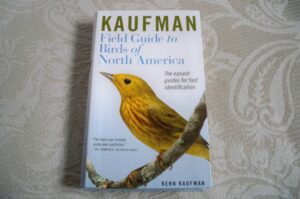
Kaufman Field Guide to Birds of North America also stands out as one of the best bird books due to its unique digital advantages, wealth of details, and user-friendly layout. Created by renowned bird expert Kenn Kaufman, it is an essential guide for birdwatchers.
Spanning over 385 pages, the Kaufman Field Guide covers over 750 species across North America. While many field guides utilize artwork or photographs, this book combines both with a twist – the artwork is digitally enhanced to showcase important field marks and details that aid identification. Subtle plumage tones, inconspicuous patterns, and faint markings are all digitally accented to pop out. I find this invaluable when consulting the guide to ID a new bird.
In addition to the enhanced artwork, the descriptive text provides key details for each species. To supplement the visuals, you’ll find tips on voices, behaviors, habitat preferences, and movements. Icons denote important traits like migration, rarity, sexual dimorphism, and feeding. Intuitive range maps show distribution. As a travel blogger, these details help me know what species to expect in each region. The Compare Similar Species sections are invaluable for distinguishing tricky birds like sparrows or sandpipers.
The layout and design make the Kaufman Field Guide easy to use in the field. The pages are made of durable paper that withstands rugged field use. At 4.25 x 7 inches, the slim profile is perfect for carrying in a pocket. Tabbed sections allow quick access to major bird groups when making ID comparisons. Icons mark each species’ frequency and seasonality. The layout thoughtfully places related species near each other too.
For these reasons, the Kaufman Field Guide to Birds of North America is one of the best bird books for travelers and experts. Retailing around $20, it delivers outstanding value through the digitally enhanced artwork, wealth of descriptive details, and intuitive layout. The light weight and compact size make it the ideal field companion. I would strongly recommend it for any North American birder’s collection.
The Crossley ID Guide: Eastern Birds
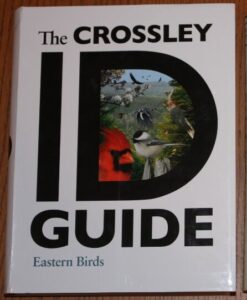
Of all the field guides I’ve tested, The Crossley ID Guide: Eastern Birds is an exceptionally innovative and useful guide for birders of all skill levels. Created by acclaimed birder and photographer Richard Crossley, it provides a fresh approach to bird IDs.
Spanning over 560 pages, the Crossley Guide covers over 385 species across eastern North America. The highlight is undoubtedly the collection of over 10,000 digitally edited photographs to showcase birds in various plumages, poses, habitats, distances, and behaviors. This unique composite approach allows direct visual comparison of similar species side-by-side, invaluable for identification in the field. The images depict the birds as you would commonly see them, not isolated studio shots.
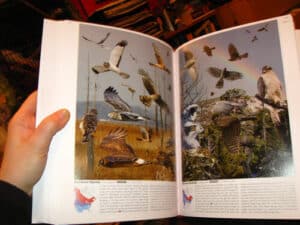
In addition to the pioneering composite images, the text provides incredibly detailed accounts for each species. You’ll find tips on field marks, vocalizations, movements, behaviors, habitat preferences, and range maps. I appreciate the details noting regional variations and distribution patterns across the eastern United States and Canada. Icons quickly denote key facts like migration, rarity, sexual dimorphism, and feeding behaviors.
Of course, usability is also essential for a field guide. The Crossley Guide features a sturdy flexibinding that allows it to lay flat when open – critical for reference in the field. The pages stand up well to repeated use in rugged conditions. At 6.5 x 9.5 inches, it’s a bit large for a pocket but remains highly portable. The useful introductions provide identification tips tailored to beginners versus advanced birders.
For its innovative composite images, wealth of descriptive details, and user-friendly format, the The Crossley ID Guide: Eastern Birds provides immense value and deserves a spot among the best bird books available today. Retailing around $35, it is a worthy investment for birders of all skill levels exploring eastern North America. It is an indispensable guide that has revolutionized my approach to field identification.
Conclusion
Having field-tested these guides extensively over the years, I can vouch that they are among the best bird books available today. For the combination of illustrated details, informative text, innovative approaches, accessibility, and durability they provide, these indispensable references have helped countless bird enthusiasts reliably identify the diverse species found across North America. I hope this review helps fellow birders determine which guidebooks best suit their needs and experience level. The hardest part is deciding which of these fantastic resources to acquire first! I encourage all bird lovers to pick one or two that interest you. These best bird books will surely enrich your knowledge and appreciation of birds, whether at home or on your travels.
